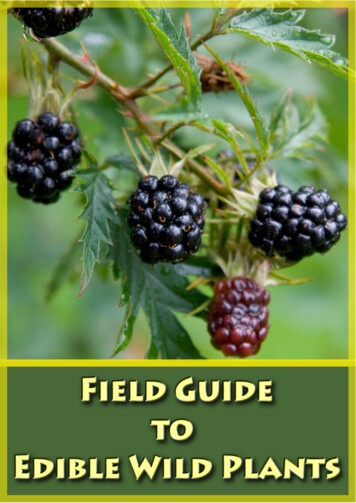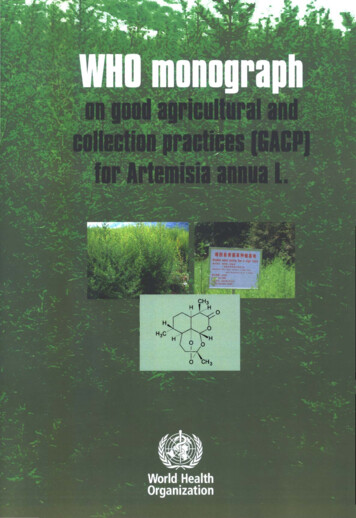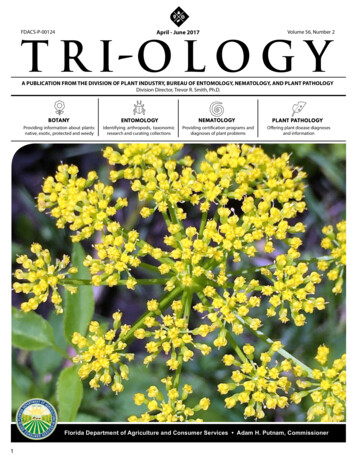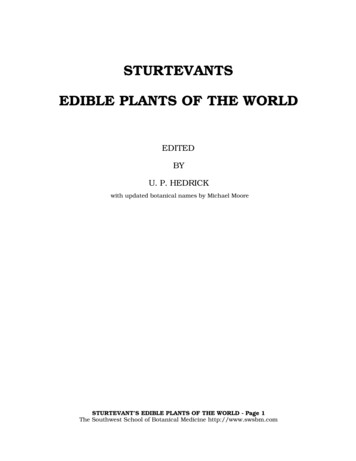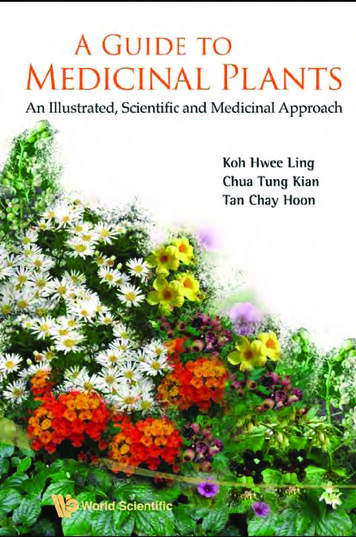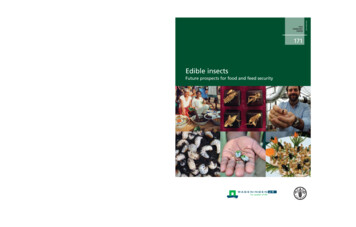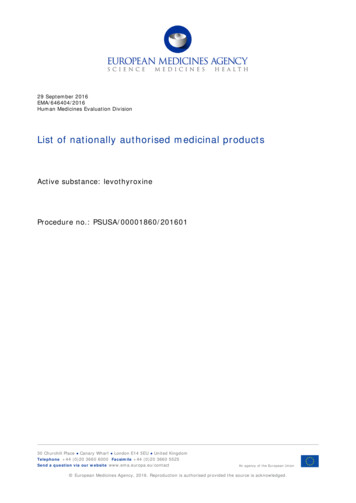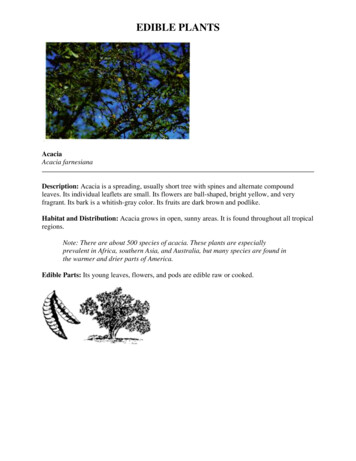
Transcription
EDIBLE PLANTSAcaciaAcacia farnesianaDescription: Acacia is a spreading, usually short tree with spines and alternate compoundleaves. Its individual leaflets are small. Its flowers are ball-shaped, bright yellow, and veryfragrant. Its bark is a whitish-gray color. Its fruits are dark brown and podlike.Habitat and Distribution: Acacia grows in open, sunny areas. It is found throughout all tropicalregions.Note: There are about 500 species of acacia. These plants are especiallyprevalent in Africa, southern Asia, and Australia, but many species are found inthe warmer and drier parts of America.Edible Parts: Its young leaves, flowers, and pods are edible raw or cooked.
AgaveAgave speciesDescription: These plants have large clusters of thick, fleshy leaves borne close to the groundand surrounding a central stalk. The plants flower only once, then die. They produce a massiveflower stalk.Habitat and Distribution: Agaves prefer dry, open areas. They are found throughout CentralAmerica, the Caribbean, and parts of the western deserts of the United States and Mexico.Edible Parts: Its flowers and flower buds are edible. Boil them before eating.CAUTIONThe juice of some species causes dermatitis in some individuals.Other Uses: Cut the huge flower stalk and collect the juice for drinking. Some species have veryfibrous leaves. Pound the leaves and remove the fibers for weaving and making ropes. Mostspecies have thick, sharp needles at the tips of the leaves. Use them for sewing or making hacks.The sap of some species contains a chemical that makes the sap suitable for use as a soap.AmaranthAmaranthus species
Description: These plants, which grow 90 centimeters to 150 centimeters tall, are abundantweeds in many parts of the world. All amaranth have alternate simple leaves. They may havesome red color present on the stems. They bear minute, greenish flowers in dense clusters at thetop of the plants. Their seeds may be brown or black in weedy species and light-colored indomestic species.Habitat and Distribution: Look for amaranth along roadsides, in disturbed waste areas, or asweeds in crops throughout the world. Some amaranth species have been grown as a grain cropand a garden vegetable in various parts of the world, especially in South America.Edible Parts: All parts are edible, but some may have sharp spines you should remove beforeeating. The young plants or the growing tips of alder plants are an excellent vegetable. Simplyboil the young plants or eat them raw. Their seeds are very nutritious. Shake the tops of alderplants to get the seeds. Eat the seeds raw, boiled, ground into flour, or popped like popcorn.ArrowrootMaranta and Sagittaria speciesDescription: The arrowroot is an aquatic plant with arrow-shaped leaves and potatolike tubers inthe mud.Habitat and Distribution: Arrowroot is found worldwide in temperate zones and the tropics. Itis found in moist to wet habitats.Edible Parts: The rootstock is a rich source of high quality starch. Boil the rootstock and eat itas a vegetable.
BambooVarious species including Bambusa, Dendrocalamus, PhyllostachysDescription: Bamboos are woody grasses that grow up to 15 meters tall. The leaves are grasslikeand the stems are the familiar bamboo used in furniture and fishing poles.Habitat and Distribution: Look for bamboo in warm, moist regions in open or jungle country,in lowland, or on mountains. Bamboos are native to the Far East (Temperate and Tropical zones)but have bean widely planted around the world.Edible Parts: The young shoots of almost all species are edible raw or cooked. Raw shoots havea slightly bitter taste that is removed by boiling. To prepare, remove the tough protective sheaththat is coated with tawny or red hairs. The seed grain of the flowering bamboo is also edible.Boil the seeds like rice or pulverize them, mix with water, and make into cakes.Other Uses: Use the mature bamboo to build structures or to make containers, ladles, spoons,and various other cooking utensils. Also use bamboo to make tools and weapons. You can makea strong bow by splitting the bamboo and putting several pieces together.CAUTIONGreen bamboo may explode in a fire. Green bamboo has an internal membrane you must removebefore using it as a food or water container.
Banana and plantainMusa speciesDescription: These are treelike plants with several large leaves at the top. Their flowers areborne in dense hanging clusters.Habitat and Distribution: Look for bananas and plantains in open fields or margins of forestswhere they are grown as a crop. They grow in the humid tropics.Edible Parts: Their fruits are edible raw or cooked. They may be boiled or baked. You can boiltheir flowers and eat them like a vegetable. You can cook and eat the rootstocks and leaf sheathsof many species. The center or "heart" or the plant is edible year-round, cooked or raw.Other Uses: You can use the layers of the lower third of the plants to cover coals to roast food.You can also use their stumps to get water (see Chapter 6). You can use their leaves to wrap otherfoods for cooking or storage.Batoko plumFlacourtia inermisDescription: This shrub or small tree has dark green, alternate, simple leaves. Its fruits are brightred and contain six or more seeds.Habitat and Distribution: This plant is a native of the Philippines but is widely cultivated forits fruit in other areas. It can be found in clearings and at the edges of the tropical rain forests ofAfrica and Asia.Edible Parts: Eat the fruit raw or cooked.
BignayAntidesma buniusDescription: Bignay is a shrub or small tree, 3 to 12 meters tall, with shiny, pointed leaves about15 centimeters long. Its flowers are small, clustered, and green. It has fleshy, dark red or blackfruit and a single seed. The fruit is about 1 centimeter in diameter.Habitat and Distribution: This plant is found in rain forests and semievergreen seasonal forestsin the tropics. It is found in open places and in secondary forests. It grows wild from theHimalayas to Ceylon and eastward through Indonesia to northern Australia. However, it may befound anywhere in the tropics in cultivated forms.Edible Parts: The fruit is edible raw. Do not eat any other parts of the tree. In Africa, the rootsare toxic. Other parts of the plant may be poisonous.CAUTIONEaten in large quantities, the fruit may have a laxative effect.BreadfruitArtocarpus incisa
Description: This tree may grow up to 9 meters tall. It has dark green, deeply divided leaves thatare 75 centimeters long and 30 centimeters wide. Its fruits are large, green, ball-like structures upto 30 centimeters across when mature.Habitat and Distribution: Look for this tree at the margins of forests and homesites in thehumid tropics. It is native to the South Pacific region but has been widely planted in the WestIndies and parts of Polynesia.Edible Parts: The fruit pulp is edible raw. The fruit can be sliced, dried, and ground into flourfor later use. The seeds are edible cooked.Other Uses: The thick sap can serve as glue and caulking material. You can also use it asbirdlime (to entrap small birds by smearing the sap on twigs where they usually perch).BurdockArctium lappaDescription: This plant has wavy-edged, arrow-shaped leaves and flower heads in burrlikeclusters. It grows up to 2 meters tall, with purple or pink flowers and a large, fleshy root.Habitat and Distribution: Burdock is found worldwide in the North Temperate Zone. Look forit in open waste areas during the spring and summer.Edible Parts: Peel the tender leaf stalks and eat them raw or cook them like greens. The rootsare also edible boiled or baked.CAUTIONDo not confuse burdock with rhubarb that has poisonous leaves.Other Uses: A liquid made from the roots will help to produce sweating and increase urination.Dry the root, simmer it in water, strain the liquid, and then drink the strained liquid. Use the fiberfrom the dried stalk to weave cordage.
Burl PalmCorypha elataDescription: This tree may reach 18 meters in height. It has large, fan-shaped leaves up to 3meters long and split into about 100 narrow segments. It bears flowers in huge dusters at the topof the tree. The tree dies after flowering.Habitat and Distribution: This tree grows in coastal areas of the East Indies.Edible Parts: The trunk contains starch that is edible raw. The very tip of the trunk is also edibleraw or cooked. You can get large quantities of liquid by bruising the flowering stalk. The kernelsof the nuts are edible.CAUTIONThe seed covering may cause dermatitis in some individuals.Other Uses: You can use the leaves as weaving material.Canna lilyCanna indica
Description: The canna lily is a coarse perennial herb, 90 centimeters to 3 meters tall. The plantgrows from a large, thick, underground rootstock that is edible. Its large leaves resemble those ofthe banana plant but are not so large. The flowers of wild canna lily are usually small, relativelyinconspicuous, and brightly colored reds, oranges, or yellows.Habitat and Distribution: As a wild plant, the canna lily is found in all tropical areas,especially in moist places along streams, springs, ditches, and the margins of woods. It may alsobe found in wet temperate, mountainous regions. It is easy to recognize because it is commonlycultivated in flower gardens in the United States.Edible Parts: The large and much branched rootstocks are full of edible starch. The youngerparts may be finely chopped and then boiled or pulverized into a meal. Mix in the young shootsof palm cabbage for flavoring.Carob treeCeratonia siliquaDescription: This large tree has a spreading crown. Its leaves are compound and alternate. Itsseedpods, also known as Saint John's bread, are up to 45 centimeters long and are filled withround, hard seeds and a thick pulp.Habitat and Distribution: This tree is found throughout the Mediterranean, the Middle East,and parts of North Africa.Edible Parts: The young tender pods are edible raw or boiled. You can pulverize the seeds inmature pods and cook as porridge.
CattailTypha latifoliaDescription: Cattails are grasslike plants with strap-shaped leaves 1 to 5 centimeters wide andgrowing up to 1.8 meters tall. The male flowers are borne in a dense mass above the femaleflowers. These last only a short time, leaving the female flowers that develop into the browncattail. Pollen from the male flowers is often abundant and bright yellow.Habitat and Distribution: Cattails are found throughout most of the world. Look for them infull sun areas at the margins of lakes, streams, canals, rivers, and brackish water.Edible Parts: The young tender shoots are edible raw or cooked. The rhizome is often verytough but is a rich source of starch. Pound the rhizome to remove the starch and use as a flour.The pollen is also an exceptional source of starch. When the cattail is immature and still green,you can boil the female portion and eat it like corn on the cob.Other Uses: The dried leaves are an excellent source of weaving material you can use to makefloats and rafts. The cottony seeds make good pillow stuffing and insulation. The fluff makesexcellent tinder. Dried cattails are effective insect repellents when burned.Cereus cactusCereus species
Description: These cacti are tall and narrow with angled stems and numerous spines.Habitat and Distribution: They may be found in true deserts and other dry, open, sunny areasthroughout the Caribbean region, Central America, and the western United States.Edible Parts: The fruits are edible, but some may have a laxative effect.Other Uses: The pulp of the cactus is a good source of water. Break open the stem and scoop outthe pulp.ChufaCyperus esculentusDescription: This very common plant has a triangular stem and grasslike leaves. It grows to aheight of 20 to 60 centimeters. The mature plant has a soft furlike bloom that extends from awhorl of leaves. Tubers 1 to 2.5 centimeters in diameter grow at the ends of the roots.Habitat and Distribution: Chufa grows in moist sandy areas throughout the world. It is often anabundant weed in cultivated fields.Edible Parts: The tubers are edible raw, boiled, or baked. You can also grind them and use themas a coffee substitute.
CoconutCocos nuciferaDescription: This tree has a single, narrow, tall trunk with a cluster of very large leaves at thetop. Each leaf may be over 6 meters long with over 100 pairs of leaflets.Habitat and Distribution: Coconut palms are found throughout the tropics. They are mostabundant near coastal regions.Edible Parts: The nut is a valuable source of food. The milk of the young coconut is rich insugar and vitamins and is an excellent source of liquid. The nut meat is also nutritious but is richin oil. To preserve the meat, spread it in the sun until it is completely dry.Other Uses: Use coconut oil to cook and to protect metal objects from corrosion. Also use theoil to treat saltwater sores, sunburn, and dry skin. Use the oil in improvised torches. Use the treetrunk as building material and the leaves as thatch. Hollow out the large stump for use as a foodcontainer. The coconut husks are good flotation devices and the husk's fibers are used to weaveropes and other items. Use the gauzelike fibers at the leaf bases as strainers or use them to weavea bug net or to make a pad to use on wounds. The husk makes a good abrasive. Dried husk fiberis an excellent tinder. A smoldering husk helps to repel mosquitoes. Smoke caused by drippingcoconut oil in a fire also repels mosquitoes. To render coconut oil, put the coconut meat in thesun, heat it over a slow fire, or boil it in a pot of water. Coconuts washed out to sea are a goodsource of fresh liquid for the sea survivor.Common jujubeZiziphus jujubaDescription: The common jujube is either a deciduous tree growing to a height of 12 meters or alarge shrub, depending upon where it grows and how much water is available for growth. Itsbranches are usually spiny. Its reddish-brown to yellowish-green fruit is oblong to ovoid, 3centimeters or less in diameter, smooth, and sweet in flavor, but has rather dry pulp around acomparatively large stone. Its flowers are green.Habitat and Distribution: The jujube is found in forested areas of temperate regions and indesert scrub and waste areas worldwide. It is common in many of the tropical and subtropicalareas of the Old World. In Africa, it is found mainly bordering the Mediterranean. In Asia, it is
especially common in the drier parts of India and China. The jujube is also found throughout theEast Indies. It can be found bordering some desert areas.Edible Parts: The pulp, crushed in water, makes a refreshing beverage. If time permits, you candry the ripe fruit in the sun like dates. Its fruits are high in vitamins A and C.CranberryVaccinium macrocarponDescription: This plant has tiny leaves arranged alternately. Its stem creeps along the ground. Itsfruits are red berries.Habitat and Distribution: It only grows in open, sunny, wet areas in the colder regions of theNorthern Hemisphere.Edible Parts: The berries are very tart when eaten raw. Cook in a small amount of water andadd sugar, if available, to make a jelly.Other Uses: Cranberries may act as a diuretic. They are useful for treating urinary tractinfections.
DandelionTaraxacum officinaleDescription: Dandelion leaves have a jagged edge, grow close to the ground, and are seldommore than 20 centimeters long. Its flowers are bright yellow. There are several dandelion species.Habitat and Distribution: Dandelions grow in open, sunny locations throughout the NorthernHemisphere.Edible Parts: All parts are edible. Eat the leaves raw or cooked. Boil the roots as a vegetable.Roots roasted and ground are a good coffee substitute. Dandelions are high in vitamins A and Cand in calcium.Other Uses: Use the white juice in the flower stems as glue.Date palmPhoenix dactyliferaDescription: The date palm is a tall, unbranched tree with a crown of huge, compound leaves.Its fruit is yellow when ripe.Habitat and Distribution: This tree grows in arid semitropical regions. It is native to NorthAfrica and the Middle East but has been planted in the arid semitropics in other parts of theworld.Edible Parts: Its fruit is edible fresh but is very bitter if eaten before it is ripe. You can dry thefruits in the sun and preserve them for a long time.Other Uses: The trunks provide valuable building material in desert regions where few othertreelike plants are found. The leaves are durable and you can use them for thatching and asweaving material. The base of the leaves resembles coarse cloth that you can use for scrubbingand cleaning.
DaylilyHemerocallis fulvaDescription: This plant has unspotted, tawny blossoms that open for 1 day only. It has long,swordlike, green basal leaves. Its root is a mass of swollen and elongated tubers.Habitat and Distribution: Daylilies are found worldwide in Tropic and Temperate Zones. Theyare grown as a vegetable in the Orient and as an ornamental plant elsewhere.Edible Parts: The young green leaves are edible raw or cooked. Tubers are also edible raw orcooked. You can eat its flowers raw, but they taste better cooked. You can also fry the flowersfor storage.CAUTIONEating excessive amounts of raw flowers may cause diarrhea.Fishtail palmCaryota urens
Description: Fishtail palms are large trees, at least 18 meters tall. Their leaves are unlike thoseof any other palm; the leaflets are irregular and toothed on the upper margins. All other palmshave either fan-shaped or featherlike leaves. Its massive flowering shoot is borne at the top of thetree and hangs downward.Habitat and Distribution: The fishtail palm is native to the tropics of India, Assam, and Burma.Several related species also exist in Southeast Asia and the Philippines. These palms are found inopen hill country and jungle areas.Edible Parts: The chief food in this palm is the starch stored in large quantities in its trunk. Thejuice from the fishtail palm is very nourishing and you have to drink it shortly after getting itfrom the palm flower shoot. Boil the juice down to get a rich sugar syrup. Use the same methodas for the sugar palm to get the juice. The palm cabbage may be eaten raw or cooked.Goa beanPsophocarpus tetragonolobusDescription: The goa bean is a climbing plant that may cover small shrubs and trees. Its beanpods are 22 centimeters long, its leaves 15 centimeters long, and its flowers are bright blue. Themature pods are 4-angled, with jagged wings on the pods.Habitat and Distribution: This plant grows in tropical Africa, Asia, the East Indies, thePhilippines, and Taiwan. This member of the bean (legume) family serves to illustrate a kind ofedible bean common in the tropics of the Old World. Wild edible beans of this sort are mostfrequently found in clearings and around abandoned garden sites. They are more rare in forestedareas.Edible Parts: You can eat the young pods like string beans. The mature seeds are a valuablesource of protein after parching or roasting them over hot coals. You can germinate the seeds (asyou can many kinds of beans) in damp moss and eat the resultant sprouts. The thickened rootsare edible raw. They are slightly sweet, with the firmness of an apple. You can also eat the youngleaves as a vegetable, raw or steamed.
LotusNelumbo speciesDescription: There are two species of lotus: one has yellow flowers and the other pink flowers.The flowers are large and showy. The leaves, which may float on or rise above the surface of thewater, often reach 1.5 meters in radius. The fruit has a distinctive flattened shape and contains upto 20 hard seeds.Habitat and Distribution: The yellow-flowered lotus is native to North America. The pinkflowered species, which is widespread in the Orient, is planted in many other areas of the world.Lotuses are found in quiet fresh water.Edible Parts: All parts of the plant are edible raw or cooked. The underwater parts contain largequantities of starch. Dig the fleshy portions from the mud and bake or boil them. Boil the youngleaves and eat them as a vegetable. The seeds have a pleasant flavor and are nutritious. Eat themraw, or parch and grind them into flour.MalangaXanthosoma caracuDescription: This plant has soft, arrow-shaped leaves, up to 60 centimeters long. The leaveshave no aboveground stems.
Habitat and Distribution: This plant grows widely in the Caribbean region. Look for it in open,sunny fields.Edible Parts: The tubers are rich in starch. Cook them before eating to destroy a poisoncontained in all parts of the plant.WARNINGAlways cook before eating.MangoMangifera indicaDescription: This tree may reach 30 meters in height. It has alternate, simple, shiny, dark greenleaves. Its flowers are small and inconspicuous. Its fruits have a large single seed. There aremany cultivated varieties of mango. Some have red flesh, others yellow or orange, often withmany fibers and a kerosene taste.Habitat and Distribution: This tree grows in warm, moist regions. It is native to northern India,Burma, and western Malaysia. It is now grown throughout the tropics.Edible Parts: The fruits area nutritious food source. The unripe fruit can be peeled and its flesheaten by shredding it and eating it like a salad. The ripe fruit can be peeled and eaten raw.Roasted seed kernels are edible.CAUTIONIf you are sensitive to poison ivy, avoid eating mangoes, as they cause a severe reaction insensitive individuals.
ManiocManihot utillissimaDescription: Manioc is a perennial shrubby plant, 1 to 3 meters tall, with jointed stems and deepgreen, fingerlike leaves. It has large, fleshy rootstocks.Habitat and Distribution: Manioc is widespread in all tropical climates, particularly in moistareas. Although cultivated extensively, it maybe found in abandoned gardens and growing wildin many areas.Edible Parts: The rootstocks are full of starch and high in food value. Two kinds of manioc areknown: bitter and sweet. Both are edible. The bitter type contains poisonous hydrocyanic acid.To prepare manioc, first grind the fresh manioc root into a pulp, then cook it for at least 1 hour toremove the bitter poison from the roots. Then flatten the pulp into cakes and bake as bread.Manioc cakes or flour will keep almost indefinitely if protected against insects and dampness.Wrap them in banana leaves for protection.CAUTIONFor safety, always cook the roots of either type.
MulberryMorus speciesDescription: This tree has alternate, simple, often lobed leaves with rough surfaces. Its fruits areblue or black and many seeded.Habitat and Distribution: Mulberry trees are found in forests, along roadsides, and inabandoned fields in Temperate and Tropical Zones of North America, South America, Europe,Asia, and Africa.Edible Parts: The fruit is edible raw or cooked. It can be dried for eating later.CAUTIONWhen eaten in quantity, mulberry fruit acts as a laxative. Green, unripe fruit can behallucinogenic and cause extreme nausea and cramps.Other Uses: You can shred the inner bark of the tree and use it to make twine or cord.
Nipa palmNipa fruticansDescription: This palm has a short, mainly underground trunk and very large, erect leaves up to6 meters tall. The leaves are divided into leaflets. A flowering head forms on a short erect sternthat rises among the palm leaves. The fruiting (seed) head is dark brown and may be 30centimeters in diameter.Habitat and Distribution: This palm is common on muddy shores in coastal regions throughouteastern Asia.Edible Parts: The young flower stalk and the seeds provide a good source of water and food.Cut the flower stalk and collect the juice. The juice is rich in sugar. The seeds are hard butedible.Other Uses: The leaves are excellent as thatch and coarse weaving material.Papaya or pawpawCarica papayaDescription: The papaya is a small tree 1.8 to 6 meters tall, with a soft, hollow trunk. When cut,the entire plant exudes a milky juice. The trunk is rough and the leaves are crowded at the trunk'sapex. The fruit grows directly from the trunk, among and below the leaves. The fruit is greenbefore ripening. When ripe, it turns yellow or remains greenish with a squashlike appearance.Habitat and Distribution: Papaya is found in rain forests and semievergreen seasonal forests intropical regions and in some temperate regions as well. Look for it in moist areas near clearingsand former habitations. It is also found in open, sunny places in uninhabited jungle areas.Edible Parts: The ripe fruit is high in vitamin C. Eat it raw or cock it like squash. Place greenfruit in the sun to make it ripen quickly. Cook the young papaya leaves, flowers, and stemscarefully, changing the water as for taro.
CAUTIONBe careful not to get the milky sap from the unripe fruit into your eyes. It will cause intense painand temporary--sometimes even permanent--blindness.Other Uses: Use the milky juice of the unripe fruit to tenderize tough meat. Rub the juice on themeat.PinePinus speciesDescription: Pine trees are easily recognized by their needlelike leaves grouped in bundles. Each bundlemay contain one to five needles, the number varying among species. The tree's odor and sticky sapprovide a simple way to distinguish pines from similar looking trees with needlelike leaves.Habitat and Distribution: Pines prefer open, sunny areas. They are found throughout NorthAmerica, Central America, much of the Caribbean region, North Africa, the Middle East,Europe, and some places in Asia.Edible Parts: The seeds of all species are edible. You can collect the young male cones, whichgrow only in the spring, as a survival food. Boil or bake the young cones. The bark of youngtwigs is edible. Peel off the bark of thin twigs. You can chew the juicy inner bark; it is rich insugar and vitamins. Eat the seeds raw or cooked. Green pine needle tea is high in vitamin C.Other Uses : Use the resin to waterproof articles. Also use it as glue. Collect the resin from thetree. If there is not enough resin on the tree, cut a notch in the bark so more sap will seep out. Putthe resin in a container and heat it. The hot resin is your glue. Use it as is or add a small amountof ash dust to strengthen it. Use it immediately. You can use hardened pine resin as anemergency dental filling.
Plantain, broad and narrow leafPlantago speciesDescription: The broad leaf plantain has leaves over 2.5 centimeters across that grow close tothe ground. The flowers are on a spike that rises from the middle of the cluster of leaves. Thenarrow leaf plantain has leaves up to 12 centimeters long and 2.5 centimeters wide, covered withhairs. The leaves form a rosette. The flowers are small and inconspicuous.Habitat and Distribution: Look for these plants in lawns and along roads in the NorthTemperate Zone. This plant is a common weed throughout much of the world.Edible Parts: The young tender leaves are edible raw. Older leaves should be cooked. Seeds areedible raw or roasted.Other Uses: To relieve pain from wounds and sores, wash and soak the entire plant for a shorttime and apply it to the injured area. To treat diarrhea, drink tea made from 28 grams (1 ounce)of the plant leaves boiled in 0.5 liter of water. The seeds and seed husks act as laxatives.Rattan palmCalamus species
Description: The rattan palm is a stout, robust climber. It has hooks on the midrib of its leavesthat it uses to remain attached to trees on which it grows. Sometimes, mature stems grow to 90meters. It has alternate, compound leaves and a whitish flower.Habitat and Distribution: The rattan palm is found from tropical Africa through Asia to theEast Indies and Australia. It grows mainly in rain forests.Edible Parts: Rattan palms hold a considerable amount of starch in their young stem tips. Youcan eat them roasted or raw. In other kinds, a gelatinous pulp, either sweet or sour, surrounds theseeds. You can suck out this pulp. The palm heart is also edible raw or cooked.Other Uses: You can obtain large amounts of potable water by cutting the ends of the longstems (see Chapter 6). The stems can be used to make baskets and fish traps.ReedPhragmites australisDescription: This tall, coarse grass grows to 3.5 meters tall and has gray-green leaves about 4centimeters wide. It has large masses of brown flower branches in early summer. These rarelyproduce grain and become fluffy, gray masses late in the season.Habitat and Distribution: Look for reed in any open, wet area, especially one that has beendisturbed through dredging. Reed is found throughout the temperate regions of both the Northernand Southern Hemispheres.Edible Parts: All parts of the plant are edible raw or cooked in any season. Harvest the stems asthey emerge from the soil and boil them. You can also harvest them just before they produceflowers, then dry and beat them into flour. You can also dig up and boil the underground stems,but they are often tough. Seeds are edible raw or boiled, but they are rarely found.
Rose appleEugenia jambosDescription: This tree grows 3 to 9 meters high. It has opposite, simple, dark green, shinyleaves. When fresh, it has fluffy, yellowish-green flowers and red to purple egg-shaped fruit.Habitat and Distribution: This tree is widely planted in all of the tropics. It can also be foundin a semiwild state in thickets, waste places, and secondary forests.Edible Parts: The entire fruit is edible raw or cooked.Sago palmMetroxylon saguDescription: These palms are low trees, rarely over 9 meters tall, with a stout, spiny trunk. Theouter rind is about 5 centimeters thick and hard as bamboo. The rind encloses a spongy inner pithcontaining a high proportion of starch. It has typical palmlike leaves clustered at the tip.
Habitat and Distribution: Sago palm is found in tropical rain forests. It flourishes in damplowlands in the Malay Peninsula, New Guinea, Indonesia, the Philippines, and adjacent islands.It is found mainly in swamps and along streams, lakes, and rivers.Edible Parts: These palms, when av
Description: The canna lily is a coarse perennial herb, 90 centimeters to 3 meters tall. The plant grows from a large, thick, underground rootstock that is edible. Its large leaves resemble those of the banana plant but are not so large. The
